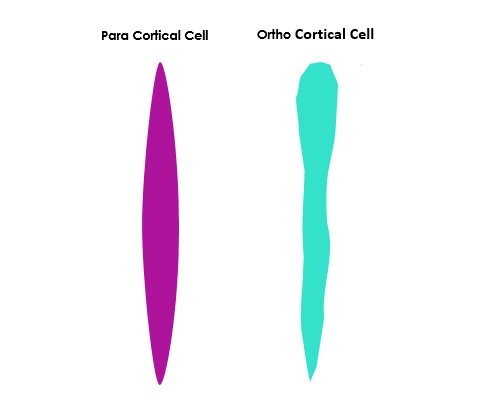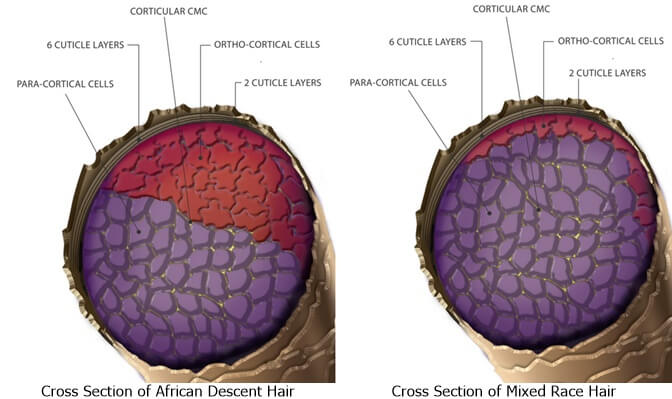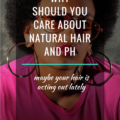Wow, it’s not really a shocker! We expect that when two races come together the hair is bound come out different. The reality is, from my experience in my family, anything can happen. Mixed race hair is not a guarantee of straighter or less “kinkier” hair, I’ve seen surprising things. I like to say that “Hair is Hair” and that we should focus not on the differences and on comparing, but on having healthy hair. However, I was surprised to know that mixed race hair really is different from African descent hair when it comes to damage.
How so?
Well, it all happens at the structural level of the hair, the cortex to be more exact. There is where you’ll find keratin, the main constituent of hair that is formed by a combination of several amino acids. Out of these, cysteine stands out because nearly 1/4 of keratin is made from it and when two cysteine amino acids join together they form a cystine (not cysteine) molecule.
Now pay attention, these cystine molecules are super important when it comes to damage inflicted to our hair. They form cross-links in the hair fibre, also known as disulphide bonds, that are instrumental in hair strength. Disulphide bonds are what maintain the curliness of your hair, but more importantly, they lend strength and elasticity to the hair fibre. Unlike hydrogen bonds which can be broken when wet and reset once dry, disulphide bonds only lose their properties when permed, relaxed or because of excessive heat. In translation, all changes you witness in curl pattern are changes happening to the cystine cross-links/disulphide bonds.
How Does This Relate To Mixed And African Hair?
Yes, what I’ve explained so far relates to a change in the hair fibre that happens across all ethnic hair types. What is different across all of them is what is found in the cortex when we take a look at a cross section of the hair. Several studies inform us that the cortex is made of (protein related) cortical cells of which there are two types: para-cortical and ortho–cortical cells.

As you can see from the image above these cells differ in appearance. Although they both have a spindle-like shape para-cortical cells (PCCs) are uniform whereas ortho-cortical cells (OCCs) are not, they are irregular. Other important differences between the two are that the OCCs have less cystine, have less matrix or cell membrane complex (CMC – binds/keeps cortical cells in place) and are less resistant to heat and chemical damage than PCCs.
Just to be clear, this means that OCCs in comparison to PPCs:
- Are not as strong and elastic because they have fewer disulphide bonds.
- Have less matrix/CMC, meaning that the “glue” that holds the OCCs together offers less stability to the cells, which become more vulnerable to stretching and combing.
- Are more vulnerable to heat and chemical damage due to less cystine.
Now, what is different between mixed and African descent hair is the distribution of these cells in the cortex and what it means for these hair types. But before we move on please understand that there are 3 main ethnic groups: Caucasian, Asian and African. When I refer to mixed hair I mean a crossover between African and another ethnic group.
How Are Cortical Cells Arranged Then?
African descent hair has an equal number of para and ortho-cortical cells, thus why we have curly hair that differs in diameter along its length. This is also what makes natural hair more fragile than Caucasian and Asian hair. African hair is elliptical in shape, almost like a flat ribbon, therefore, more vulnerable to damage.

Mixed hair, on the other hand, has more para-cortical cells than ortho-cortical cells hence a more uniform diameter along the hair shaft and a waiver, not so coily/kinky shape. Adding to all these changes, the side where the OCCs lie have a thinner cuticle layer protecting the cortex, which means a higher probability for damage to occur in African hair since it has more of these cells (OCCs).
What Does This All Mean?
When looking at all this information we can conclude that it’s not just the cortical cells that dictate the differences between mixed and African hair. Here are the main characteristics that set them apart when it comes to damage to the hair strand:
- Mixed hair is stronger and more resilient to chemical and thermal damage because it has more para-cortical cells than ortho-cortical cells,
- The presence of more PCC in mixed hair means more cystine, more disulphide bonds which translate to stronger and more elastic hair.
- Having more cell membrane complex (CMC) not only holds the cortical cells in place, but it also means that mixed hair is more resistant to manipulation from combing and stretching.
- Mixed hair has more cuticle layers over the ortho-cortical cells than African hair, which means the latter is more fragile to external damage.
I found all of this very interesting. I know that Asian, Caucasian and African hair are different between themselves and that within these groups there are sub-groups. However, I thought that all hair from a structural point of view had the same vulnerability to chemical treatments and heat styling practices (or even environmental conditions). The determining factors were the protective measures taken to minimise or completely avoid hair damage. To my surprise, the cortical cells in our hair also have a say.
Will This information Change How You Care For Your Hair?
I don’t know, but if you put your hair under any chemical treatment or heat straightening procedure you might want to make sure that you are protecting your hair (read about dying with henna).
Additionally, having a proper diet is not only good for hair health in general, but it can also increase the production of cysteine amino acid, which will increase cystine in hair making it stronger and more elastic. Aim to eat chicken, pork, dairy, legumes, broccoli and whole grains as a source of cysteine or take supplements.
Reducing hair manipulation because of reduced CMC (cell membrane complex) in African hair is also advisable to avoid breakage.
As I write this, I know that many of you, regardless of having mixed or African hair, are already protecting and boosting the health your hair. Therefore, this information won’t change much of what yu are doing already it will only come as an increase in your hair knowledge. However, for those of you who are not protecting, nourishing and nurturing your hair, this may be your warning sign.
Will this information change the way you care and protect your hair?







6 thoughts on “Mixed Race Hair Really Is Different!”
Nice article but you really could have used more educated terms to compare hair other than “mixed” and “afro”. Im NOT mixed and I have ringlet curls and my hair is a silkier texture for lack of a better word so again you could have used better terms. Also, I have seen biracial people with afro hair as you describe it in this article. Please revise, this is way too vague
Hi, Zara!
I am glad you found this article informational in some way, I love it when readers enjoy the information they find here. This article is not meant to compare the aesthetics of mixed and African descent hair (nor does it try to), it talks about how different they are in their internal structure and how that relates to hair damage because they can look exactly the same on the outside. Hence, me saying at the beginning that “mixed raced hair is not a guarantee of straighter or less “kinkier” hair” or, has you say, silkier (I do not use the term “afro” but African hair or African descent).
I am sorry if this didn’t come across clearly to you, maybe I need to reword this so other readers don’t get confused.
Thanks for your feedback.
Mónica
No she doesn’t have to change a damn thing. Stop being embarrassed/jealous/hurt by the truth.
I too am confused by this article. Would love to be part of this study. Much love from Africa
Should the shampoo and conditioner products change because of the difference in hair structures? What products do you recommend for each?
Products are chosen to address specific hair needs and styling needs and you should also have into consideration formulation and consistency since, generally, fine hair gets weighed down with heavy products and coarser hair doesn’t.